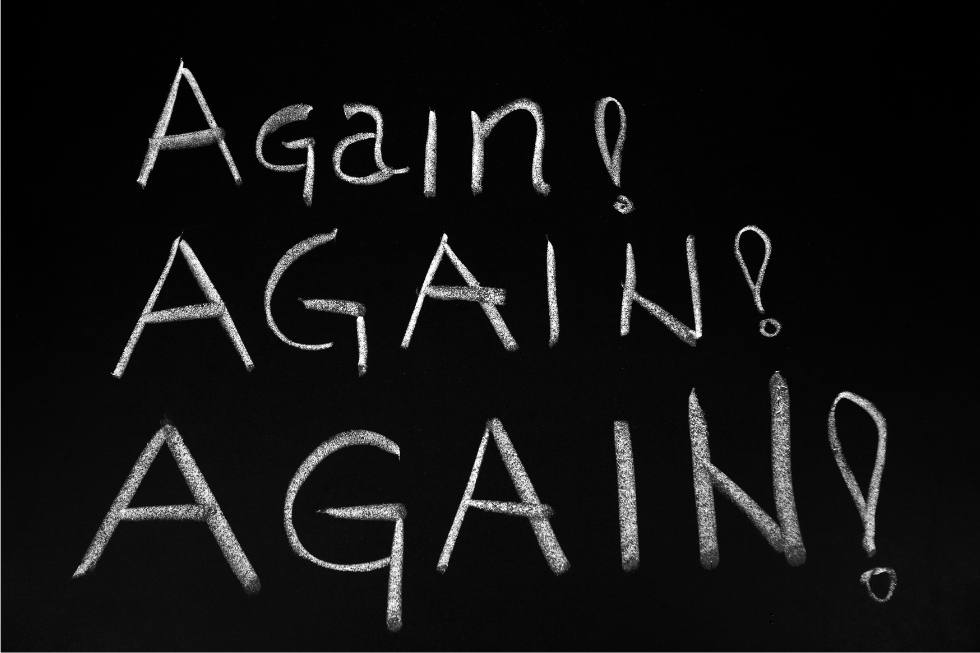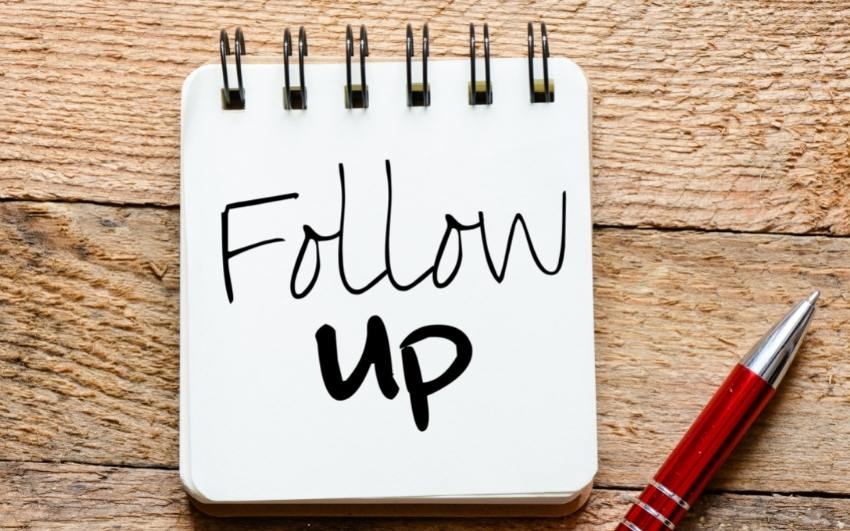On this page

Follow Up Statistics in Sales and Marketing
Closing sales isn’t easy. According to follow up statistics, only 2% of sales occur during the first point of contact, on average. Even if you do one sales call or send one follow-up email, you could be losing up to 98 percent of your sales.
That is a significant amount of profit that is lost.
And on top of that, a recent study on follow up statistics by the Sales Management Association found that only 37% of salespeople always follow up with their prospects after an initial meeting.
Many salespeople never follow up with prospects because they are afraid of rejection, have a difficult (or no) sales procedure, or lack automation. This can be the difference between your business getting all the sales it needs or struggling. Why? Because if you just get into the habit of following up, this would mean:
- More closed sales
- More attentive clients because you cared enough to call them
- Growing business
Whether you’re a small business owner, or a large enterprise, we know you don’t always have the resources to know everything there is to know about all follow up statistics. So in this guide, we’ve put together thirty five follow up stats to help you get your marketing basics right for your business.
Before we get into the thirty five follow up statistics, here are some key facts to consider:
Follow Up Statistics in Sales

It’s no secret that sales are a numbers game. The more calls you make, the more emails you send, and your chances of making a sale are better.
But what many salespeople don’t realize is that the real key to success is follow-up.
According to follow up statistics, following up properly can help you grow your business 19x faster.
Sales follow up is an important step in the sales process, yet many salespeople fail to do it effectively. Or at all.
A recent study on follow up statistics by the Sales Management Association found that only 37% of salespeople always follow up with their prospects after an initial meeting.
This number drops to 22% when following up after a proposal according to follow up statistics.
Why is follow up so important?
Because without the follow up, you’re leaving deals and cash on the table. The same study found that 43% of salespeople said they’d be more likely to win a deal if they followed up more effectively.
There are several reasons why salespeople struggle with follow-up.
- And yet, only 19% said they were very effective at follow-up.
- The most common reason cited was a lack of time (27%), followed by a lack of resources (23%).
- Other reasons included poor customer relationships (21%), a lack of training (17%), and not knowing what to say (11%).
If you’re struggling with follow-up, you can do a few things to improve your success rate.
First, be sure to have an organized system for tracking your prospects and when you last contacted them. This will help you stay efficient in contacting people so that the best possible leads come through!
35 Sales Follow Up Statistics
In order to get a sale, it is important to follow up with prospects. After a sale, it is important to follow up with clients.
Follow up is key.
Let’s look at some numbers to get an idea about the effectiveness of following up with prospective clients.
Let’s have a look at sales follow up statistics.
Follow Up Productivity Statistics for Sales

Productivity is important in building a solid sales follow-up technique.
Here are some facts to assist you in developing creative solutions for boosting your sales team’s productivity.
1. On average, 42.5% of salespeople take ten months or more to be productive enough to contribute to a firm’s bottom line after ten weeks of training and development.
2. Only 34% of the time do salespeople spend time “selling”.
According to follow up statistics, the remaining 66 percent of their time is spent as follows:
- 21% of respondents said they send emails.
- 17% of the work is data entry.
- Training – 11%
- 17% of respondents find it difficult to obtain contact information for prospective customers.
- Attending internal meetings costs 12% of your time.
- Minutes spent on scheduling meetings – 12%
- 11% of online merchants use the cloud to help them manage their marketing and sales functions.
3. Sales development reps perform many activities every day.
These actions result in 14.1 interactions, 16.7 chances, and 3.7 sales closed per day, and they are structured as follows:
- 35.9 estimated phone calls.
- 32.6 emails.
- Around 15.3 voicemails on average.
- 7 social media touches.
4. The finest sales onboarding programs help new sales hires become productive 3.4 months sooner than firms with low-performing programs – a time-to-productivity advantage of 37%.
5. On average, technology-user firms were 57% less effective at sales training and development than organizations that used technology effectively.
Sales Channel Follow-Up Statistics

The sales channel you’re using may impact the success of your follow-ups.
Here are some follow-up statistics based on the sales channel you’re using.
Email channel follow up
- According to research, followup email marketing has a 20% higher return on investment (ROI) than cold calling or trade shows.
- It’s worth noting that “I’ve received a bonus offer from your company” is the most popular subject line, according to 9.1 percent of respondents.
- According to statistics, more than 91.5% of outreach emails are discarded.
- According to a recent survey, 60% of employees make spelling or grammatical mistakes in their emails, so it’s critical to perform a grammar check on them before sending.
- The recipient’s first name should be included in the subject line to improve open rates by 29.3 percent.
Phone call follow up
- Cold calling is still alive and well. According to the Harvard Business Review, almost half of high-growth firms (55%) see cold calling as effective.
- According to one study, outreach on the phone out-converts email outreach by a wide margin: 8.21% vs. 0.03 percent.
- It takes about 52 calls to sell the average sales development rep each day.
- The average voicemail response rate is around 4.8%.
- It’s estimated that only 10% of all calls are answered. More than 90 percent of people who make the first call to a company don’t get an answer. According to statistics, less than 10% of all voicemail messages are listened to.
Texting follow up
- Prospects who get text messages have a 40 percent higher conversion rate than those who don’t.
- Texts are more effective as a follow-up than as initial contact. Texting before a phone conversation reduces the prospect’s chance of becoming a leader.
- After establishing contact, texting someone improves leads to engagement conversion by 112.6 percent.
Social media channel follow up
- 45% more sales possibilities for social media users than those who aren’t active.
- According to a HubSpot study, sales reps who utilize social media as a sales channel are 51 percent more likely to achieve their sales goals than those who don’t.
- According to LinkedIn’s research, 84% of sales representatives with more than 5,000 connections on LinkedIn exceed their goals.
- According to a recent study, 82 percent of social media salespeople do better than their peers.
Multi-channel selling follow up
- Reps who use three or more touchpoints to sell have 28% higher MQL-to-SQL conversion rates than those that make a phone call or send an email.
- When you send emails to leads between phone contact attempts, your chance of reaching them rises by 16%.
Statistics For the Number of Times A Company Sends Out Sales Follow-Ups
A well-put-together cadence makes following up with clients a breeze for salespeople. Here are some statistics to help you construct one for your company.
- Within a 2–4-week time period, high-growth firms have, on average, 16 touchpoints with each prospect.
- The optimum number of follow-up emails to send is 2-3.
- The 6th call attempt has a 98.5% success rate in reaching the intended audience.
- A follow-up attempt is defined as a contact made by the salesperson after a conversation with the buyer. A whopping 44% of salespeople stop following up after one try. That’s a lot of people who are potentially missing out on sales because they don’t see the value in making follow-up attempts. There are several reasons why follow-up attempts are important. First, it shows that you’re interested in the sale and willing to put in the extra effort to make sure it goes through. Second, it allows you to answer any buyer’s questions about the product or service.
- If you’ve ever been in sales, you know that making a sale can be challenging. According to some estimates, 87% of salespeople give up after just four attempts to contact a potential customer. And even when a salesperson does manage to connect with a customer, they often face further challenges. Studies have shown that 60% of consumers will say “no” four times before they finally agree to make a purchase. This no-nonsense attitude can make it difficult to close a sale, but it’s important to remember that every “no” brings you one step closer to a “yes.” So, if you’re in sales, don’t give up after just a few attempts. And if you’re a consumer, try not to be too quick to say no. Remember that every interaction has the potential to lead to a sale.
- The response time is important. When the winning vendor does not respond for a long period, the purchase rate goes up to 60%.
Sales Follow-Up Response Time Statistics

Sometimes, prospects take a long time to react to your follow-up attempts. Here’s some data on the matter.
- In a study of 433 firms, only 7% of businesses responded in the first five minutes after form submission. Over 50% of respondents did not respond within five working days. The study found that the average response time was 2.5 days, with a median of 1.8 days.
- The study also found that most respondents (90%) used email to communicate with the firm and that phone and snail mail were used less frequently. The study concluded that businesses need to improve their response times, particularly in the age of email and instant communication.
- Those that attempted to contact leads within one hour had 7x the probability of having productive talks with decision-makers as those who waited even 60 minutes.
- On average, it takes 8 follow-ups to contact a prospect.
- According to a recent study, email responses are usually received within 60 minutes.
- If the receiver responds to an email, there’s a 90% chance it will be done within two days.
B2B Data and Effective Sales Follow Up Statistics

Sales follow-up is one of the most important aspects of the sales process, yet it is often overlooked.
- According to a recent study, only 22% of salespeople make a follow-up call after the first meeting.
- This statistic is even lower for B2B sales, where only 10% of salespeople make a follow-up call.
- The importance of follow-up cannot be underestimated. Of those who make a follow-up call, 80% successfully close the sale.
- In addition, data shows that following up with leads within 24 hours can result in a 7x higher likelihood of conversion.
With such compelling data, it’s clear that sales follow-up is essential to the success of any business. By following up with every lead, businesses can dramatically increase their chances of making a sale.
The Success of Sales Follow-Up

The success of sales follow-up can mean the difference between a one-time customer and a lifelong client. By definition, follow-up is maintaining contact with a person after an initial meeting or transaction. In sales, follow-up typically takes the form of a phone call, email, or personal visit.
Follow-up aims to build relationships, offer support, and close deals. When done correctly, follow-up can be an incredibly effective way to increase sales and grow your business.
However, there are a few key things to keep in mind if you want to make the most of your follow-up efforts:
- Always be professional and courteous.
- Focus on your customer’s needs; don’t try to sell them something they don’t need or want.
- Be patient; good things come to those who wait.
By following these simple tips, you can ensure that your sales follow-up will be successful.
Elements Of a Successful Sales Follow-Up

A successful sales follow-up can mean the difference between a one-time customer and a lifelong client. But what elements are necessary for an effective follow-up?
- First, it’s important to act quickly. The fresher their transaction memory will be, the sooner you get in touch with a customer after a sale.
- Second, be sure to personalize your follow-up. A generic form letter is likely to end up in the trash; a handwritten note, on the other hand, will make a lasting impression.
- Third, don’t be afraid to ask for feedback. Whether positive or negative, feedback can help you improve your products or services and increase your chances of making future sales.
You can turn every sale into a long-term relationship by following these simple tips.
When To Use Each Type of Sales Follow-Up
There are many different types of sales follow-ups, and each has its advantages and disadvantages. The most important thing is to choose the right type of follow-up for the situation.
For example, if you’re trying to reach a decision-maker who is hard to get in touch with, an email might be the best option. It’s quick and easy to send, and you can include additional information in attachments.
However, if you’re following up with a potential customer you’ve already met in person, a phone call might be better. It allows you to build rapport and get a sense of their needs. Ultimately, the best way to determine which follow-up type is to experiment with what works best for you and your customers.
How To Use Each Type of Sales Follow-Up
When it comes to sales, follow-up is key. Following up with your customers and clients helps build relationships, close deals, and boost your bottom line.
But what’s the best way to follow up? It depends on the situation.
Here’s a quick guide to using each type of sales follow-up:
- A phone call or email is often the best way to follow up with potential customers.
- You can use these channels to provide more information about your product or service and answer any questions they may have.
- If you’re following up with a customer who has already purchased from you, a phone call or personal visit is usually good.
- This allows you to thank them for their business and see how they use your product or service.
- If you’re trying to close a deal, a face-to-face meeting is usually best.
- This gives you a chance to build rapport and show your potential client why you’re the right choice for the job.
No matter what type of sales follow-up you’re doing, it’s important to be polite, professional, and considerate of your customer’s time.
Related:
Conclusion
It’s no secret that sales are a numbers game. The more calls you make, the more emails you send, and your chances of making a sale are better.
But what many salespeople don’t realize is that the real key to success is follow-up.
According to follow-up statistics in sales, a buyer rarely purchases at first contact, so it’s important to keep the lines of communication open and continue to nurture the relationship. Fortunately, you can do some simple things to improve your follow-up game:
- Make sure you have a system to track your interactions with buyers. This will help you keep tabs on who you’ve contacted and when, so you can follow up at the right time.
- Set yourself reminders for when to follow up. Whether adding a task to your to-do list or setting a calendar alert, taking this extra step will ensure that you don’t forget to reach out.
- Be sure to personalize your follow-ups.
A generic email or voicemail is likely to be ignored, but a personalized message will show that you’re truly invested in the relationship. You can take your follow-up game to the next level and close more deals by following these simple tips.
FAQs
What percentage of sales is followed up?
According to a recent survey of sales professionals on follow-up statistics in sales, only 37% of sales are followed up. This means that 63% of potential sales are left on the table. While there are many possible reasons for this, one of the most common is that salespeople don’t have the time to follow up with every lead.
Another reason is that they may not have a system to track follow-ups. Regardless of the reason, the fact remains that follow-up is essential to closing more sales. By following up with leads, salespeople can stay top-of-mind and increase their chances of making a sale.
Furthermore, follow-up provides an opportunity to build relationships and better understand customers’ needs. When done properly, follow-up can be a powerful tool for driving sales.
How many follow-ups are too many sales?
The general rule of thumb in sales is that it takes seven follow-ups to close a deal. However, this number is just an average, and the reality is that some deals will be closed after just a few follow-ups while others may require more. If a salesperson consistently makes seven or more follow-ups without seeing any results, it may be time to reassess their approach.
On the other hand, if a salesperson is close to landing a deal but decides to give up after a few follow-ups, they may miss an opportunity. The key is to balance being persistent and know when to move on. By maintaining this balance, salespeople can increase their chances of success while avoiding the pitfalls of both over-and under-selling.
Is follow-up important in sales?
Anyone who has ever been in sales knows that follow-up is essential. After all, the sale is not complete until the product or service has been delivered, and the customer is satisfied. By following up with customers, salespeople can ensure that they are happy with their purchase and that no problems need to be addressed.
In addition, follow-up allows upsell or cross-sell related products and services. By staying in touch with customers, salespeople can build relationships that last a lifetime. In today’s competitive marketplace, those relationships are more important than ever.
How often should you follow up on a sales call?
The answer to the question “How often should you follow up on a sales call?” depends on several factors, including the nature of your product or service and your customers’ buying cycle. It is best to follow up within a few days of the initial call, though you may need to reach out more frequently if your product is time-sensitive.
The key is to balance being persistent and respecting your customer’s time and space. If you are too aggressive in your follow-up, you may come across as pushy or intrusive; too passive, and risk being forgotten.
By maintaining a polite and professional manner, you can increase your chances of making a sale while also building good relationships with potential clients.
Statistics for this article on follow up statistics in sales were gathered from the following sources:

Petri Maatta is a mindset coach and neuroscience-focused author with 15 years of experience in personal transformation and success psychology. After seven years of business failures, he discovered the power of manifestation through a Fortune 500 mentor. Now, he shares neuroscience-backed strategies through DreamMaker membership, helping others transform their businesses and lives on their own terms.
Read My Story here.
Share This Story, Choose Your Platform!
You want to manifest a new car, but you’re wondering: Does this really work? Here’s
Many smart individuals are often linked with having a high IQ. However, according to emotional
According to online dating statistics over 90% of people believe in love at first sight,




